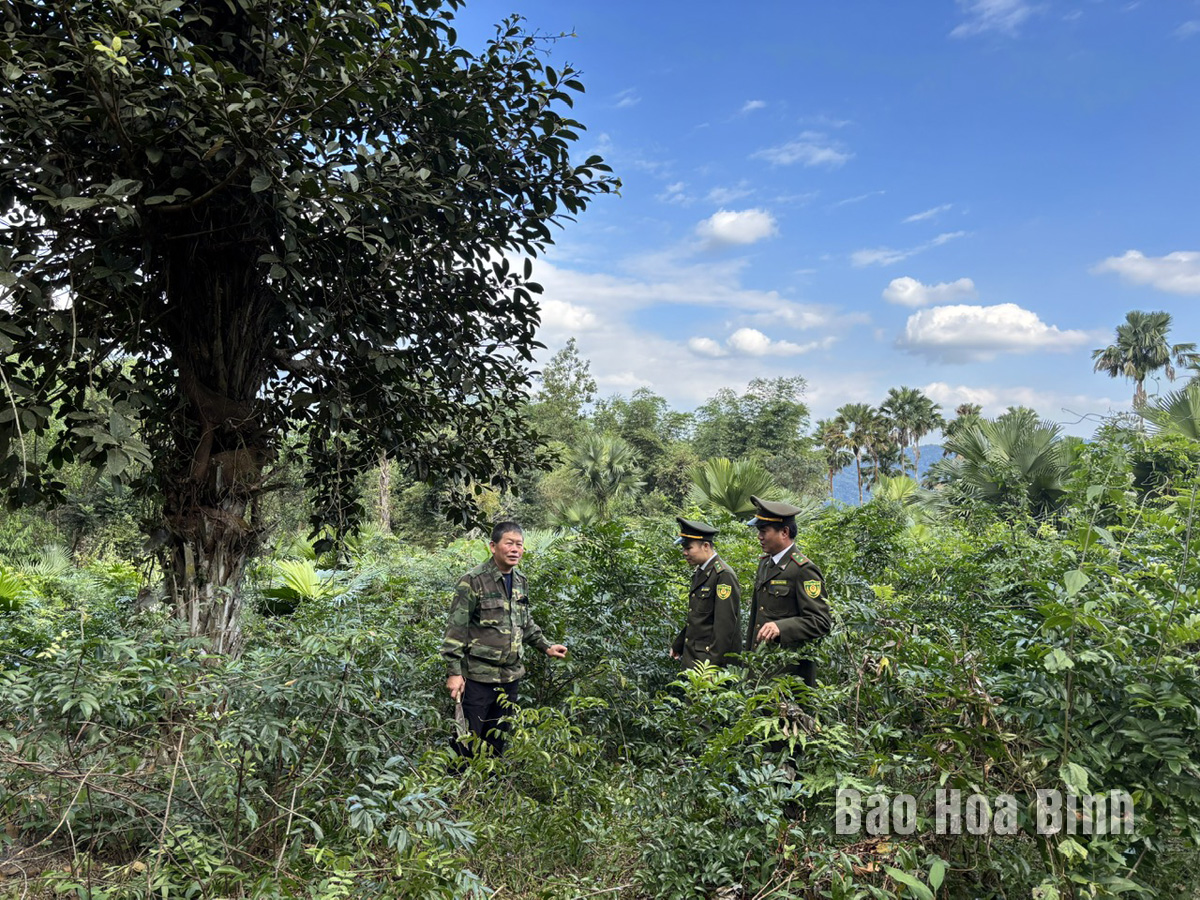


To carry out the master plan, the Hoa Binh provincial People’s Committee issued Plan No. 88-KH/UBND on April 23, 2024, to promote forest multifunctionality. This is seen as a key step toward achieving the dual goal of protecting and sustainably making use of forest value in the locality.

Staff of Mai Chau district’s forest protection division guide locals in how to cultivate ginseng in the forest in Xam Khoe commune.
Opportunities for medicinal plant cultivation models under forest canopies
Surveys show that Hoa Binh is home to a variety of valuable natural medicinal plants such as xa den (Celastrus hindsii Benth), hoai son (Dioscorea persimilis), ha thu o (Polygonum multiflorum), ba kich tim (Morinda officinalis), bghe do (red turmeric), sachi (Plukenetia volubilis), and ca gai leo (Solanum procumbens). Locals harvest around 1,170 tonnes of natural medicinal plants annually.
To support the development of medicinal plants, the provincial People’s Committee issued Decision No. 3119/QD-UBND on December 28, 2018, approving a project for developing medicinal plants through 2025, with a vision to 2030.
The goal is to zone key forest areas and the ones harbouring natural medicinal plants for the conservation of valuable, endemic, and endangered genetic resources. That is intended to ensure sustainable development of medicinal plants in the wild, and select and reasonably exploit 10 main medicinal plant species on approximately 8,000–9,000 ha of medicinal plants annually.
Under the plan, four conservation gardens and four nurseries will be established to supply seedlings for large-scale medicinal plant cultivation in the districts of Tan Lac, Lac Thuy, Yen Thuy, and Lac Son.
Additionally, the province plans to develop and expand the commercial medicinal plant farming area to a total of 15,000 hectares, with an annual output of about 80,000 to 120,000 tonnes. This includes converting 5,000 hectares of annual crop land into those for commercial medicinal plant production, and 10,000 hectares of forest land into areas for integrated medicinal plant farming, thereby gradually increasing the land-use value of designated zones.
Attention will be paid to strengthening state management in organising production and product distribution, striving for 100% of medicinal material output to be produced in a closed-loop chain, from production to processing and consumption.
According to Nguyen Huu Tai, head of the provincial forestry and forest protection sub-department, shortly after the approval of the master plan, the Prime Minister issued Decree No. 91/2024/ND-CP, dated July 18, 2024, amending and supplementing several articles of Decree No. 156/2018/ND-CP, dated November 16, 2018, which details the implementation of certain provisions of the Law on Forestry. With clear and specific regulations, the new decree outlines an important orientation for the sustainable exploitation of forest ecosystem values and creates favourable conditions for turning planned zones into practical medicinal plant cultivation models with high economic efficiency.
The provincial forest protection sector has implemented many projects aimed at forming concentrated areas of non-timber forest and medicinal materials, with priority given to those with large cultivation areas and high economic value on forest land or under forest canopies. This approach is expected to help achieve the dual goal of promoting economic development and ensuring sustainable forest protection.
Comprehensive policies, sufficient resources needed for sustainable forest development
Maximising the multifunctional value of forest ecosystems is an inevitable trend in the current period. To achieve this goal, Hoa Binh has identified five key tasks, namely developing legal wood material sources and increasing value for the wood processing industry; developing forest environmental services; developing ecological, relaxation, and entertainment tourism; developing non-timber forestry products and medicinal plants; and developing integrated agro-forestry-aquaculture models.
In recent years, the province has stepped up reviewing forest environmental services to negotiate and sign contracts, and expand revenue sources. At the same time, it has enhanced management and guided people in how to use the revenue from forest environmental services to invest in the protection and sustainable development of forests, ensuring fair sharing of benefits with locals.
Hoa Binh have been initially supported its localities in creating distinctive and standout tourism products that leverage unique cultural, natural, and ecological values.
Businesses, forest owners, and local communities have also promoted cooperation to foster sustainable tourism development, thus ensuring shared community benefits, creating jobs, and improving livelihoods.